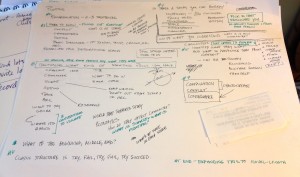
As always, everyone’s writing process is different and the only one I can speak with authority about is my own. So perhaps this will click for you and perhaps it won’t. I hope it does.
Certainly, there are stories that arrive complete. They appear in my head and all I have to do is write them down. This is most likely to occur during the night, meaning I can rise, go to the keyboard, and bang it all out quickly. For example, “Pippa’s Smiles” arrived complete and ready to go, though it had its roots in some thoughts I had been mulling over about gendered narratives. Unfortunately, though, that’s not usually how it works.
For me, stories can start in a number of ways.
- They can start as a concept or idea: What if ghosts could fly into your mouth when you yawn? What if people could go back and live their lives over and over? What if some people could acquire psychic powers?
- A story can start with a particular character. That may be someone glimpsed on the street, or a historical figure that I find interesting and want to write about. Victoria Woodhull is a American from the 19th century who I have used more than once as a character.
- It can start with a particular scene that emerges vividly in my head. I may not know who the characters are, or why they’re there, but I know what it looks like.
- It may start with a particular theme. A recent story, “Elsewhere, Within, Elsewhen,”started with me thinking about how people accumulate layers of grudges. I decided that I wanted to literalize that metaphor and the story came quickly when I began exploring that idea.
- I have on occasion decided that I want to work in a genre that I have not tried before. That’s as valid a place to start a story as any. If I’m doing that, I often try to figure out the genre conventions and decide which I want to violate. A recent piece I finished, for example, is one where I decided I wanted to try writing a piece of horror fiction that drew heavily on very visceral, physical details.
- Often my starting point is another story by someone else. Many of my stories are replies to other pieces that have influenced me: Hemingway’s The Old Man and the Sea; Robert Heinlein’s “The Menace From Earth”; O. Henry’s “The Pimaloosa Pancakes”; and Hans Christian Andersen’s “The Little Mermaid”, among others.
- A story can also start with a piece of research. I used to write encyclopedia articles and when I ran across the story of Jumbo the elephant being purchased by PT Barnum, I knew I had to write something about it, because the details were just so fabulous and Jumbo’s eventual fate so moving. That ended up becoming “The Towering Monarch of His Race.”
- A story may begin as a deliberate attempt to break a rule or guideline. I wrote “Whose Face This Is, I Do Not Know” as a reaction to one of my Clarion West classmates saying how much he hated stories where the author has a character look in a mirror in order to describe what the character looks like. I started thinking about a story in which the main character had to keep checking their appearance, because it was constantly changing.
- A story may even start with a particular title. That’s how “I’ll Gnaw Your Bones, the Manticore Said” came about. All I knew about it was that there was a manticore somewhere in the story.
Those are all perfectly valid ways to start stories, at least for me, and I’ve used all of them at least once. The question that we explored in the class is what to do with each of those in order to start figuring out the story. One way is always to just sit down and start writing, doing what Samuel R. Delany calls “writing to discover.” Sometimes that works well. Other times it may not. My trick is to usually try to figure out the characters, if I don’t have them, and particularly the main character. The most important thing to discover about that main character is what they want, because that drives their actions and helps you figure out how the story will move along.
Knowing the character and what they want helps you discover how they are being prevented from getting what they want. Once you’ve got that, you’ve got some conflict that will help drive things along.
Part of what to do next depends on your own individual process. If you are someone who cannot write the story until they know everything that will happen, then you need to figure that out, while another person may just need a initial few facts in order to sit down and start writing in order to figure out what’s going on. Personally, I would begin thinking in terms of scenes. Get a list of those together and don’t worry about the order for now. You can always rearrange them once they’re written. This is one reason why increasingly I have been drafting stories in Scrivener; that software makes it very easy to move scenes around.
How does your process differ? Have I overlooked any possible ways stories can start?






3 Responses
Great post, Cat. One could use your list as an experiment and start a story each way. When I teach, I use the first one a lot ~ What if…? I also have students do “genre mash-ups” to see what that inspires (dystopian faerie tale, cyberpunk romance). Another great inspirational activity is that 50 first lines exercise, where you write 50 first lines as fast as possible. Then take your top 5-10 and write first paragraphs to see which takes off.
I’m with you, each story grows differently, but character tends to come early on for me.
Sometimes I work my concepts into poetry and then the poetry becomes a story. More often, I write a really awful story that plants a seed for a better one. I’d call it revision, but it’s more drastic than that. It’s not a process I’d recommend.
I was happy to find “Swallowing Ghosts” on here. I very much enjoyed that story. I’ve enjoyed lots of your flash fiction. The one on Unlikely Entomology was terrific also. It’s great to be able to work in both humor and poignancy into such a short story.